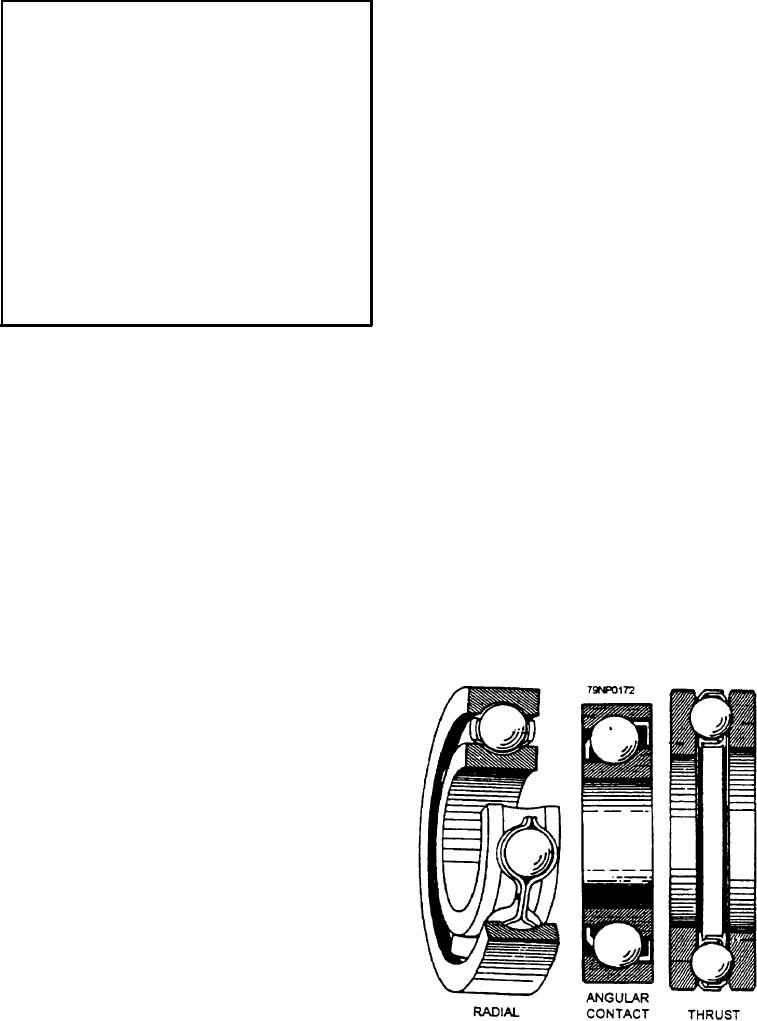
CAUTION
the Navy. These bearings are further divided into the
following three types (fig. 7-1), depending on the load
Be careful when using compressed air,
they are designed to bear:
particularly if abrasive particles are present
1. Radial. Radial bearings are capable of
because they may be driven into the insulation
supporting combined high radial and thrust
and puncture it or be forced beneath the
loads, but they aren't self-aligning. Therefore,
insulating tape. Compressed air should be used
accurate alignment between the shaft and
only after the equipment has been opened on
housing is required.
both ends to allow the air and dust to escape.
The use of compressed air will be of little
2. Angular contact. Angular contact bearings are
benefit if the dust is not suitably removed from
designed to take radial and thrust loads where
the equipment. The most suitable method to
the thrust component may be large.
remove dirt-laden air is to place a suction hose
3. Thrust. Thrust bearings are used when the load
on the opposite end of the equipment where
is completely axial rather than radial.
compressed air is being used
The ball bearings on a rotating shaft of an electric
Whenever possible, avoid the use of solvents for
motor or generator may be subjected to radial thrust
cleaning electrical equipment. However, their use is
and/or angular forces. While every ball bearing is not
necessary for removing grease and pasty substances
subjected to all three forces, any combination of one or
consisting of oil and carbon or dirt. Alcohol will injure
more may be found depending on the equipment design.
most types of insulating varnishes, and it should not be
Radial loads are the result of forces applied to the
used for cleaning electrical equipment. Because of their
bearing perpendicular to the shaft; thrust loads are the
high toxicity, solvents containing gasoline, benzene, and
result of forces applied to the bearing parallel to the
carbon tetrachloride must NEVER be used for cleaning
shaft; and angular loads are the result of a combination
purposes. Refer to chapter 1 of this manual and NSTM,
of radial and thrust loads. The load carried by the
chapter 300, for detailed information on the use of
bearings in electric motors and generators is almost
solvents for cleaning electrical machinery.
entirely due to the weight of the rotating element. For
Motors, generators, and other electrical equipment
this reason, the method of mounting the unit is a major
that have been wet with salt water should be flushed out
factor in the selection of the type of bearing installed
with fresh water and dried. Never let the equipment dry
when they are constructed. In a vertically mounted unit,
before flushing it with fresh water. For complete
the thrust bearing is used, while the radial bearing is
information on washing and drying procedures, refer to
normally used in most horizontal units.
NSTM, chapter 300.
BEARINGS
Bearings are designed to allow a rotating armature
or rotor to turn freely within a motor or generator
housing. Shaft bearings must be properly maintained to
reduce the heat caused by friction.
The two common types of bearings found in motors
and generators are antifriction bearings and friction
bearings.
ANTIFRICTION BEARINGS
There are two types of antifriction bearings--ball
and roller. Basically, both types consist of two hardened
steel rings, hardened steel rollers or balls, and
separators. The annular, ring-shaped ball bearing is the
type of roller bearing used most extensively in the
construction of electric motors and generators used in
Figure 7-1.--Representative types of ball bearings.
7-2

